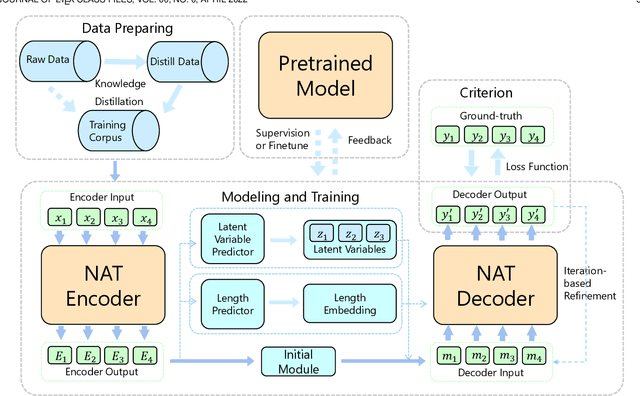Yisheng Xiao
RenewNAT: Renewing Potential Translation for Non-Autoregressive Transformer
Mar 14, 2023



Abstract:Non-autoregressive neural machine translation (NAT) models are proposed to accelerate the inference process while maintaining relatively high performance. However, existing NAT models are difficult to achieve the desired efficiency-quality trade-off. For one thing, fully NAT models with efficient inference perform inferior to their autoregressive counterparts. For another, iterative NAT models can, though, achieve comparable performance while diminishing the advantage of speed. In this paper, we propose RenewNAT, a flexible framework with high efficiency and effectiveness, to incorporate the merits of fully and iterative NAT models. RenewNAT first generates the potential translation results and then renews them in a single pass. It can achieve significant performance improvements at the same expense as traditional NAT models (without introducing additional model parameters and decoding latency). Experimental results on various translation benchmarks (e.g., \textbf{4} WMT) show that our framework consistently improves the performance of strong fully NAT methods (e.g., GLAT and DSLP) without additional speed overhead.
AMOM: Adaptive Masking over Masking for Conditional Masked Language Model
Mar 13, 2023



Abstract:Transformer-based autoregressive (AR) methods have achieved appealing performance for varied sequence-to-sequence generation tasks, e.g., neural machine translation, summarization, and code generation, but suffer from low inference efficiency. To speed up the inference stage, many non-autoregressive (NAR) strategies have been proposed in the past few years. Among them, the conditional masked language model (CMLM) is one of the most versatile frameworks, as it can support many different sequence generation scenarios and achieve very competitive performance on these tasks. In this paper, we further introduce a simple yet effective adaptive masking over masking strategy to enhance the refinement capability of the decoder and make the encoder optimization easier. Experiments on \textbf{3} different tasks (neural machine translation, summarization, and code generation) with \textbf{15} datasets in total confirm that our proposed simple method achieves significant performance improvement over the strong CMLM model. Surprisingly, our proposed model yields state-of-the-art performance on neural machine translation (\textbf{34.62} BLEU on WMT16 EN$\to$RO, \textbf{34.82} BLEU on WMT16 RO$\to$EN, and \textbf{34.84} BLEU on IWSLT De$\to$En) and even better performance than the \textbf{AR} Transformer on \textbf{7} benchmark datasets with at least \textbf{2.2$\times$} speedup. Our code is available at GitHub.
A Survey on Non-Autoregressive Generation for Neural Machine Translation and Beyond
Apr 20, 2022



Abstract:Non-autoregressive (NAR) generation, which is first proposed in neural machine translation (NMT) to speed up inference, has attracted much attention in both machine learning and natural language processing communities. While NAR generation can significantly accelerate inference speed for machine translation, the speedup comes at the cost of sacrificed translation accuracy compared to its counterpart, auto-regressive (AR) generation. In recent years, many new models and algorithms have been designed/proposed to bridge the accuracy gap between NAR generation and AR generation. In this paper, we conduct a systematic survey with comparisons and discussions of various non-autoregressive translation (NAT) models from different aspects. Specifically, we categorize the efforts of NAT into several groups, including data manipulation, modeling methods, training criterion, decoding algorithms, and the benefit from pre-trained models. Furthermore, we briefly review other applications of NAR models beyond machine translation, such as dialogue generation, text summarization, grammar error correction, semantic parsing, speech synthesis, and automatic speech recognition. In addition, we also discuss potential directions for future exploration, including releasing the dependency of KD, dynamic length prediction, pre-training for NAR, and wider applications, etc. We hope this survey can help researchers capture the latest progress in NAR generation, inspire the design of advanced NAR models and algorithms, and enable industry practitioners to choose appropriate solutions for their applications. The web page of this survey is at \url{https://github.com/LitterBrother-Xiao/Overview-of-Non-autoregressive-Applications}.
 Add to Chrome
Add to Chrome Add to Firefox
Add to Firefox Add to Edge
Add to Edge